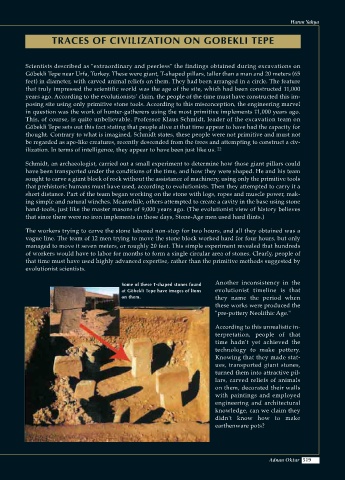Page 521 - Atlas of Creation Volume 2
P. 521
Harun Yahya
TRACES OF CIVILIZATION ON GOBEKLI TEPE
Scientists described as "extraordinary and peerless" the findings obtained during excavations on
Göbekli Tepe near Urfa, Turkey. These were giant, T-shaped pillars, taller than a man and 20 meters (65
feet) in diameter, with carved animal reliefs on them. They had been arranged in a circle. The feature
that truly impressed the scientific world was the age of the site, which had been constructed 11,000
years ago. According to the evolutionists' claim, the people of the time must have constructed this im-
posing site using only primitive stone tools. According to this misconception, the engineering marvel
in question was the work of hunter-gatherers using the most primitive implements 11,000 years ago.
This, of course, is quite unbelievable. Professor Klaus Schmidt, leader of the excavation team on
Göbekli Tepe sets out this fact stating that people alive at that time appear to have had the capacity for
thought. Contrary to what is imagined, Schmidt states, these people were not primitive and must not
be regarded as ape-like creatures, recently descended from the trees and attempting to construct a civ-
ilization. In terms of intelligence, they appear to have been just like us. 22
Schmidt, an archaeologist, carried out a small experiment to determine how those giant pillars could
have been transported under the conditions of the time, and how they were shaped. He and his team
sought to carve a giant block of rock without the assistance of machinery, using only the primitive tools
that prehistoric humans must have used, according to evolutionists. Then they attempted to carry it a
short distance. Part of the team began working on the stone with logs, ropes and muscle power, mak-
ing simple and natural winches. Meanwhile, others attempted to create a cavity in the base using stone
hand-tools, just like the master masons of 9,000 years ago. (The evolutionist view of history believes
that since there were no iron implements in those days, Stone-Age men used hard flints.)
The workers trying to carve the stone labored non-stop for two hours, and all they obtained was a
vague line. The team of 12 men trying to move the stone block worked hard for four hours, but only
managed to move it seven meters, or roughly 20 feet. This simple experiment revealed that hundreds
of workers would have to labor for months to form a single circular area of stones. Clearly, people of
that time must have used highly advanced expertise, rather than the primitive methods suggested by
evolutionist scientists.
Some of these T-shaped stones found Another inconsistency in the
at Göbekli Tepe have images of lions evolutionist timeline is that
on them. they name the period when
these works were produced the
"pre-pottery Neolithic Age."
According to this unrealistic in-
terpretation, people of that
time hadn't yet achieved the
technology to make pottery.
Knowing that they made stat-
ues, transported giant stones,
turned them into attractive pil-
lars, carved reliefs of animals
on them, decorated their walls
with paintings and employed
engineering and architectural
knowledge, can we claim they
didn't know how to make
earthenware pots?
Adnan Oktar 519

